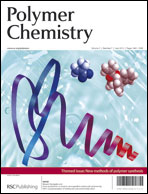Copper-free click chemistry on polymersomes: pre- vs. post-self-assembly functionalisation†
Abstract
The optimal accessibility of functional groups on polymeric nanosized vesicles was investigated with copper-free clickable probes as a model system. Cu-free clickable polymersomes were developed either through

- This article is part of the themed collection: New methods of polymer synthesis

 Please wait while we load your content...
Please wait while we load your content...